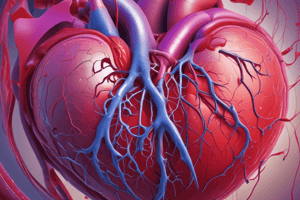Podcast
Questions and Answers
Which of the following is NOT a common risk factor for hypertension?
Which of the following is NOT a common risk factor for hypertension?
- Chronic stress
- Obesity
- Family history of HTN
- High levels of physical activity (correct)
Which symptom is associated with severe hypertension?
Which symptom is associated with severe hypertension?
- Blurry vision (correct)
- Weight gain
- Fatigue
- Nausea
What is a key nursing intervention for patients with anemia?
What is a key nursing intervention for patients with anemia?
- Encourage high-sodium diet
- Advocate for high-protein meals only
- Monitor hemoglobin and hematocrit levels (correct)
- Suggest complete bed rest at all times
Which of the following is a potential complication of untreated Deep Vein Thrombosis (DVT)?
Which of the following is a potential complication of untreated Deep Vein Thrombosis (DVT)?
What nursing intervention is appropriate for a patient diagnosed with pulmonary embolism?
What nursing intervention is appropriate for a patient diagnosed with pulmonary embolism?
Which of the following best describes a symptom of Peripheral Artery Disease (PAD)?
Which of the following best describes a symptom of Peripheral Artery Disease (PAD)?
Which of the following pathophysiological aspects is involved in the development of anemia?
Which of the following pathophysiological aspects is involved in the development of anemia?
What lifestyle change should be promoted to reduce the risk of hypertension?
What lifestyle change should be promoted to reduce the risk of hypertension?
Which medication class is often prescribed for managing hypertension?
Which medication class is often prescribed for managing hypertension?
What sign indicates a potential problem in patients with DVT?
What sign indicates a potential problem in patients with DVT?
What is one of the main goals in the nursing management of patients with anemia?
What is one of the main goals in the nursing management of patients with anemia?
Which of the following is a direct risk factor for developing pulmonary embolism?
Which of the following is a direct risk factor for developing pulmonary embolism?
How does smoking influence the risk of Peripheral Artery Disease?
How does smoking influence the risk of Peripheral Artery Disease?
Which of the following describes a common symptom of pulmonary embolism?
Which of the following describes a common symptom of pulmonary embolism?
What is the primary impact of left-sided heart failure on the body?
What is the primary impact of left-sided heart failure on the body?
Which of the following symptoms is NOT commonly associated with heart failure?
Which of the following symptoms is NOT commonly associated with heart failure?
What is considered a normal blood pressure reading?
What is considered a normal blood pressure reading?
Which of the following is a risk factor for developing heart failure?
Which of the following is a risk factor for developing heart failure?
What complication can arise from prolonged hypertension?
What complication can arise from prolonged hypertension?
Which medication is typically prescribed to manage symptoms of heart failure?
Which medication is typically prescribed to manage symptoms of heart failure?
What symptom is indicative of right-sided heart failure?
What symptom is indicative of right-sided heart failure?
Which lifestyle change is NOT recommended for managing hypertension?
Which lifestyle change is NOT recommended for managing hypertension?
Flashcards
What is Heart Failure?
What is Heart Failure?
Heart failure (HF) is a chronic condition where the heart cannot effectively pump blood to meet the body's needs. This results in inadequate oxygen and nutrient delivery to tissues and organs.
What is Left-Sided Heart Failure?
What is Left-Sided Heart Failure?
Left-sided heart failure occurs when the left ventricle struggles to pump blood to the body, leading to fluid buildup in the lungs.
What is Right-Sided Heart Failure?
What is Right-Sided Heart Failure?
Right-sided heart failure happens when the right ventricle is unable to pump blood effectively to the lungs, causing fluid accumulation in the body.
What are the risk factors for Heart Failure?
What are the risk factors for Heart Failure?
Signup and view all the flashcards
What is Hypertension?
What is Hypertension?
Signup and view all the flashcards
How does Hypertension affect the body?
How does Hypertension affect the body?
Signup and view all the flashcards
What is Anemia?
What is Anemia?
Signup and view all the flashcards
How does Anemia impact the body?
How does Anemia impact the body?
Signup and view all the flashcards
Heart Failure
Heart Failure
Signup and view all the flashcards
Hypertension (HTN)
Hypertension (HTN)
Signup and view all the flashcards
Anemia
Anemia
Signup and view all the flashcards
Deep Vein Thrombosis (DVT)
Deep Vein Thrombosis (DVT)
Signup and view all the flashcards
Pulmonary Embolism (PE)
Pulmonary Embolism (PE)
Signup and view all the flashcards
Peripheral Artery Disease (PAD)
Peripheral Artery Disease (PAD)
Signup and view all the flashcards
Fluid Overload
Fluid Overload
Signup and view all the flashcards
Pulmonary Edema
Pulmonary Edema
Signup and view all the flashcards
Antihypertensive Medication
Antihypertensive Medication
Signup and view all the flashcards
Anticoagulant Medication
Anticoagulant Medication
Signup and view all the flashcards
Fibrinolytic Medication
Fibrinolytic Medication
Signup and view all the flashcards
Perfusion
Perfusion
Signup and view all the flashcards
Intermittent Claudication
Intermittent Claudication
Signup and view all the flashcards
Hypoxia
Hypoxia
Signup and view all the flashcards
Healthy Lifestyle Modifications
Healthy Lifestyle Modifications
Signup and view all the flashcards
Study Notes
Perfusion Concept Study Guide
- Perfusion: The circulation of oxygenated blood through tissues and organs, supplying oxygen and nutrients. Impaired perfusion can lead to organ damage.
Heart Failure (HF)
- Definition: A chronic condition where the heart cannot pump blood efficiently. Left-sided and right-sided HF are possible.
- Pathophysiology (Left-sided): Left ventricle fails, leading to pulmonary congestion (fluid in lungs), symptoms include shortness of breath, fatigue, and fluid retention.
- Pathophysiology (Right-sided): Right ventricle fails, causing fluid buildup in abdomen, legs, and feet. Symptoms include peripheral edema and jugular venous distention (JVD).
- Risk Factors: Coronary artery disease, hypertension, diabetes, obesity, smoking, family history.
- Signs & Symptoms: Dyspnea, fatigue, leg/ankle/abdominal swelling, orthopnea, tachycardia.
- Nursing Interventions: Monitor vital signs (esp. respiratory rate and oxygen saturation), administer medications (diuretics, ACE inhibitors, beta-blockers), lifestyle education (low-sodium diet, weight management).
Hypertension (HTN) and Anemia
- Hypertension (HTN): Consistently high blood pressure (systolic ≥130 mm Hg and/or diastolic ≥80 mm Hg).
- Pathophysiology (HTN): Damages blood vessel walls, increases workload on the heart, and can lead to heart failure, stroke, and kidney disease.
- Risk Factors (HTN): Age, family history, obesity, inactivity, alcohol intake, high-sodium diet, stress, smoking.
- Signs & Symptoms (HTN): Often asymptomatic, headaches, dizziness, blurry vision (severe cases), chest pain, shortness of breath (extreme cases).
- Nursing Interventions (HTN): Monitor blood pressure, administer antihypertensive medications, promote lifestyle changes (diet, exercise, stress reduction).
- Anemia: Reduced red blood cells (RBCs) or hemoglobin, impairing oxygen delivery to tissues.
- Pathophysiology (Anemia): Blood loss (e.g., bleeding), poor RBC production, or increased RBC destruction. The body compensates by increasing heart rate and breathing.
- Risk Factors (Anemia): Nutritional deficiencies (iron, B12, folate), chronic diseases (e.g., kidney disease, cancer), blood loss (ulcers, heavy periods), genetic conditions (sickle cell anemia)
- Signs & Symptoms (Anemia): Fatigue, pale skin/mucous membranes, shortness of breath on exertion, dizziness, tachycardia
- Nursing Interventions (Anemia): Administer supplements (iron, B12, folate), monitor hemoglobin/hematocrit, educate on iron-rich foods, encourage rest.
Deep Vein Thrombosis (DVT), Pulmonary Embolism (PE), and Peripheral Artery Disease (PAD)
-
Deep Vein Thrombosis (DVT): Blood clot in a deep vein, often in the legs.
-
Pathophysiology (DVT): Slowed blood flow (stasis), vessel injury, increased blood clotting (Virchow's triad). Untreated can lead to pulmonary embolism.
-
Risk Factors (DVT): Prolonged immobility, hormonal therapy/pregnancy, smoking, obesity, older age, prior DVT/PE
-
Signs & Symptoms (DVT): Swelling, redness, warmth, pain/tenderness (calf), potentially asymptomatic.
-
Nursing Interventions (DVT): Elevate limb, warm compresses, administer anticoagulants (e.g., heparin, warfarin), encourage mobility and leg exercises
-
Pulmonary Embolism (PE): A blood clot travels to the lungs, blocking blood flow and causing oxygen deprivation.
-
Pathophysiology (PE): Impaired gas exchange, hypoxia, potentially life-threatening shock, or death if untreated.
-
Risk Factors (PE): Recent surgery, trauma, prolonged immobility, DVT history, smoking, obesity, certain cancers
-
Signs & Symptoms (PE): Sudden shortness of breath, chest pain, rapid breathing (tachypnea), bluish skin (cyanosis), coughing up blood (hemoptysis).
-
Nursing Interventions (PE): Administer oxygen, anticoagulation or fibrinolytics, monitor for respiratory distress, educate on DVT prevention.
-
Peripheral Artery Disease (PAD): Narrowing of peripheral arteries, reduces blood flow to limbs.
-
Pathophysiology (PAD): Primarily caused by atherosclerosis, reduces oxygen to muscles/tissues in the limbs, leading to pain and potential damage.
-
Risk Factors (PAD): Smoking, diabetes, hypertension, hyperlipidemia, older age
-
Signs & Symptoms (PAD): Intermittent claudication (leg pain during exercise, relieved by rest), numbness/weakness in legs, cool/pale skin in affected limb, poorly healing wounds/ulcers
-
Nursing Interventions (PAD): Encourage smoking cessation/exercise, medications to control blood pressure, cholesterol, and blood sugar. Promote proper foot care, monitor for infection.
Studying That Suits You
Use AI to generate personalized quizzes and flashcards to suit your learning preferences.




